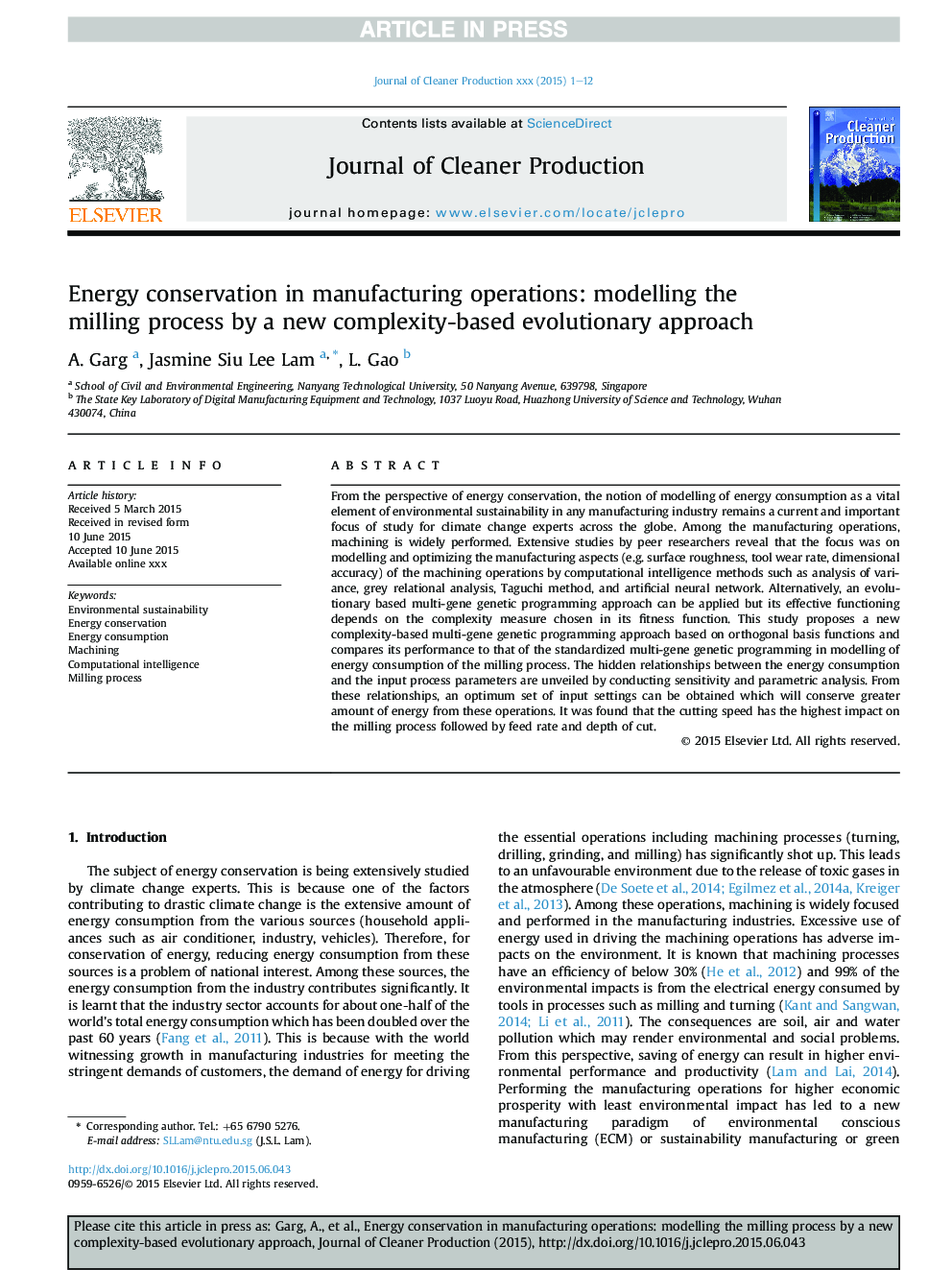| کد مقاله | کد نشریه | سال انتشار | مقاله انگلیسی | نسخه تمام متن |
|---|---|---|---|---|
| 10688140 | 1017980 | 2015 | 12 صفحه PDF | دانلود رایگان |
عنوان انگلیسی مقاله ISI
Energy conservation in manufacturing operations: modelling the milling process by a new complexity-based evolutionary approach
ترجمه فارسی عنوان
صرفه جویی در انرژی در عملیات تولید: مدل سازی فرآیند آسیاب با یک رویکرد تکاملی مبتنی بر پیچیدگی جدید
دانلود مقاله + سفارش ترجمه
دانلود مقاله ISI انگلیسی
رایگان برای ایرانیان
کلمات کلیدی
پایداری زیست محیطی، حفاظت انرژی، مصرف انرژی، ماشینکاری، هوش محاسباتی، فرآیند فرز،
ترجمه چکیده
از منظر صرفه جویی در انرژی، مفهوم مدل سازی مصرف انرژی به عنوان یک عنصر حیاتی پایدار محیط زیست در هر صنعت تولیدی، تمرکز فعلی و مهم برای بررسی کارشناسان تغییر آب وهوا در سراسر جهان است. در میان عملیات تولید، ماشینکاری به طور گسترده ای انجام می شود. مطالعات گسترده توسط محققان همکار نشان می دهد که تمرکز بر مدل سازی و بهینه سازی جنبه های تولید (مانند زبری سطح، سرعت سایش ابزار، دقت ابعاد) عملیات ماشینکاری با استفاده از روش های هوشمند محاسباتی مانند تحلیل واریانس، تحلیل رابطه خاکستری، روش تاگوچی، و شبکه عصبی مصنوعی. به جای آن، یک روش برنامه ریزی ژنتیک چند ژن مبتنی بر تکامل می تواند اعمال شود، اما عملکرد موثر آن بستگی به اندازه گیری پیچیدگی انتخاب شده در عملکرد تناسب اندام دارد. این مطالعه پیشنهاد یک روش برنامه ریزی ژنتیک چند ژنی مبتنی بر پیچیدگی مبتنی بر توابع مبنای متعامد و مقایسه عملکرد آن با برنامه نویسی ژنتیک چند ژن استاندارد شده در مدل سازی مصرف انرژی فرآیند آسیاب را مقایسه می کند. روابط پنهانی بین مصرف انرژی و پارامترهای فرآیند ورودی با انجام حساسیت و تجزیه و تحلیل پارامتری آشکار می شود. از این روابط، یک مجموعه بهینه از تنظیمات ورودی می تواند بدست آید که مقدار بیشتری از انرژی را از این عملیات ها حفظ می کند. مشخص شد که سرعت برش بیشترین تاثیر را در فرآیند آسیاب کردن دارد که به دنبال آن میزان خوراک و عمق برش می باشد.
موضوعات مرتبط
مهندسی و علوم پایه
مهندسی انرژی
انرژی های تجدید پذیر، توسعه پایدار و محیط زیست
چکیده انگلیسی
From the perspective of energy conservation, the notion of modelling of energy consumption as a vital element of environmental sustainability in any manufacturing industry remains a current and important focus of study for climate change experts across the globe. Among the manufacturing operations, machining is widely performed. Extensive studies by peer researchers reveal that the focus was on modelling and optimizing the manufacturing aspects (e.g. surface roughness, tool wear rate, dimensional accuracy) of the machining operations by computational intelligence methods such as analysis of variance, grey relational analysis, Taguchi method, and artificial neural network. Alternatively, an evolutionary based multi-gene genetic programming approach can be applied but its effective functioning depends on the complexity measure chosen in its fitness function. This study proposes a new complexity-based multi-gene genetic programming approach based on orthogonal basis functions and compares its performance to that of the standardized multi-gene genetic programming in modelling of energy consumption of the milling process. The hidden relationships between the energy consumption and the input process parameters are unveiled by conducting sensitivity and parametric analysis. From these relationships, an optimum set of input settings can be obtained which will conserve greater amount of energy from these operations. It was found that the cutting speed has the highest impact on the milling process followed by feed rate and depth of cut.
ناشر
Database: Elsevier - ScienceDirect (ساینس دایرکت)
Journal: Journal of Cleaner Production - Volume 108, Part A, 1 December 2015, Pages 34-45
Journal: Journal of Cleaner Production - Volume 108, Part A, 1 December 2015, Pages 34-45
نویسندگان
A. Garg, Jasmine Siu Lee Lam, L. Gao,
